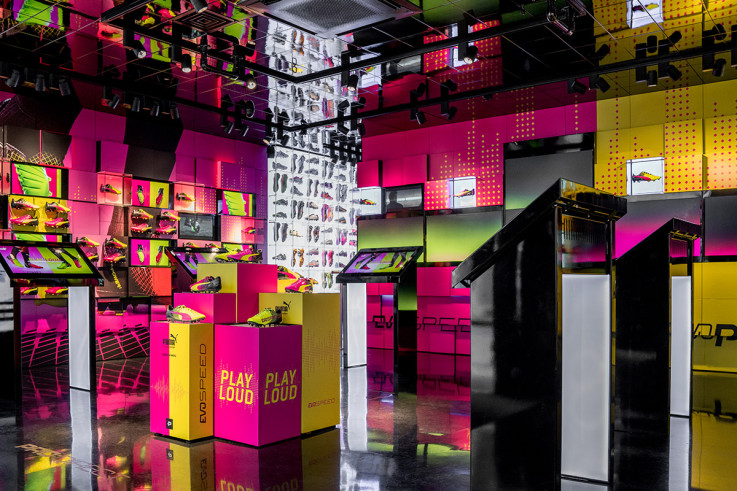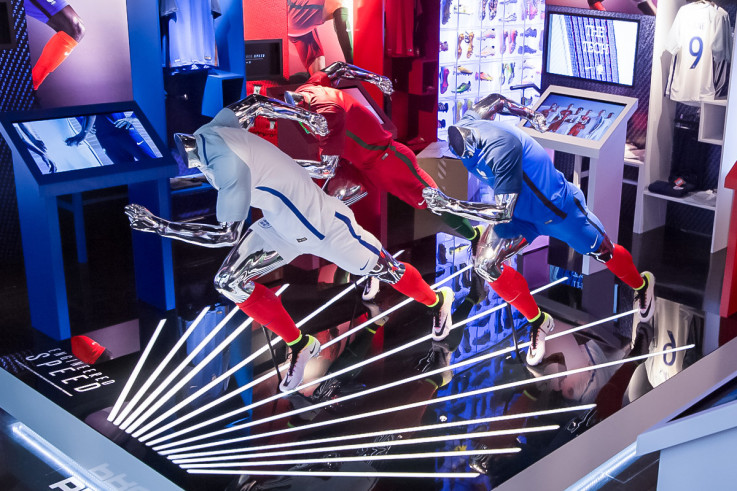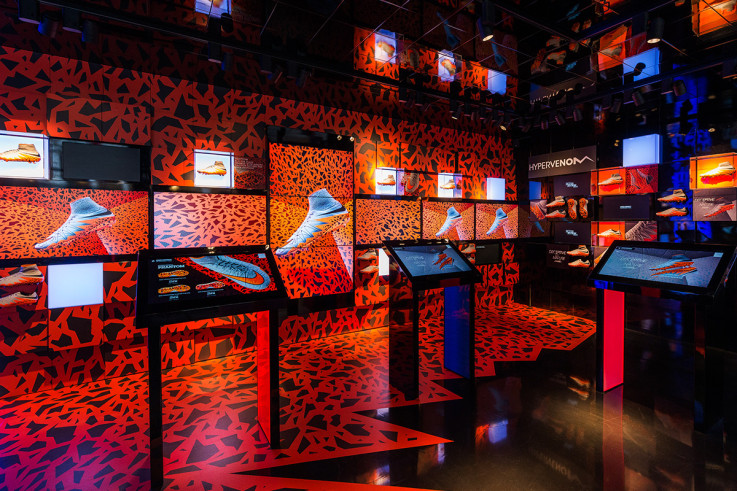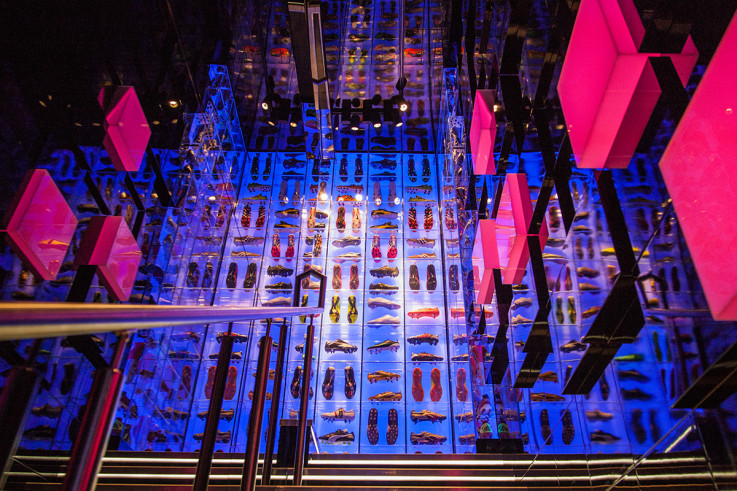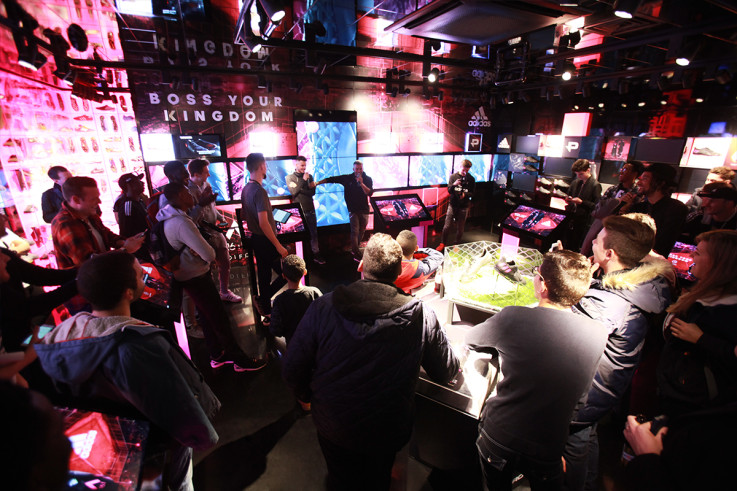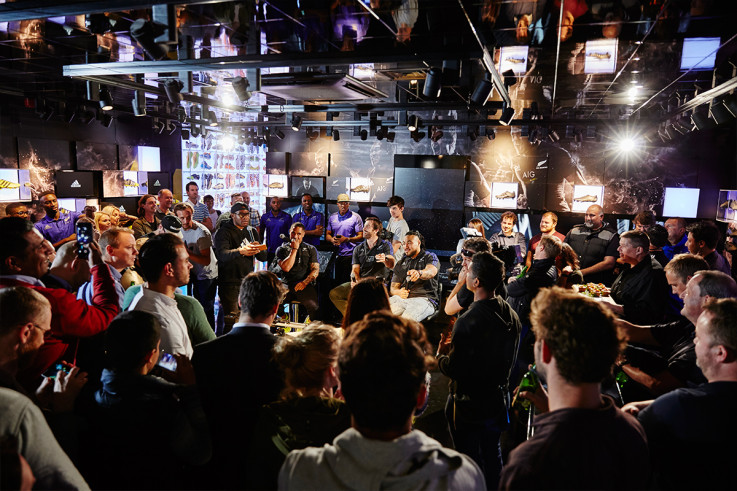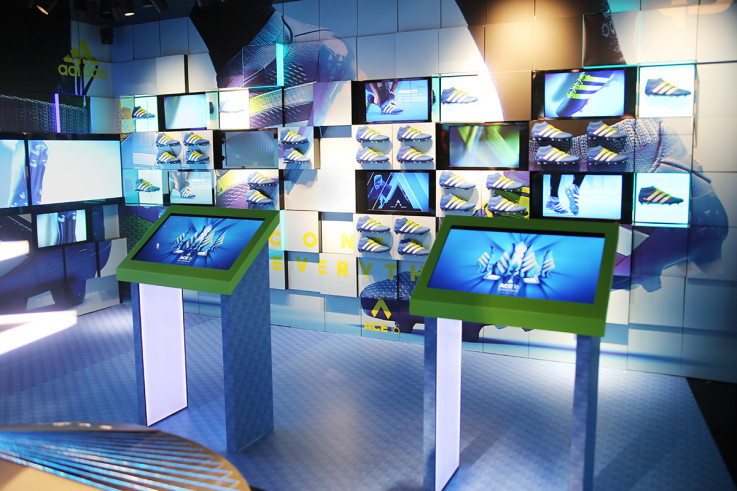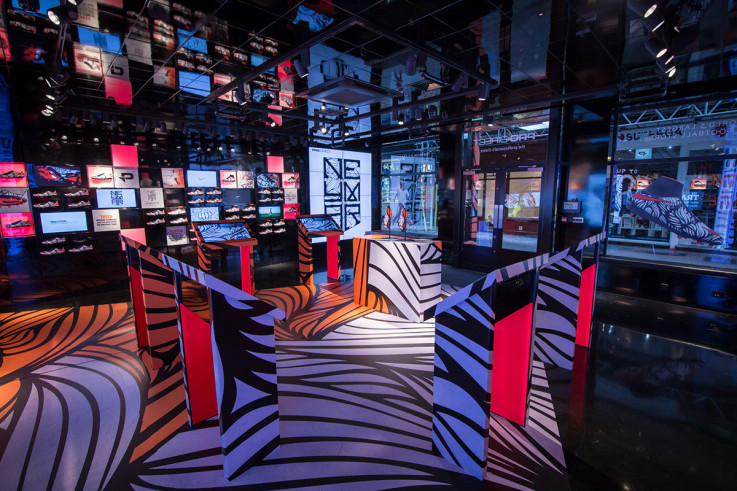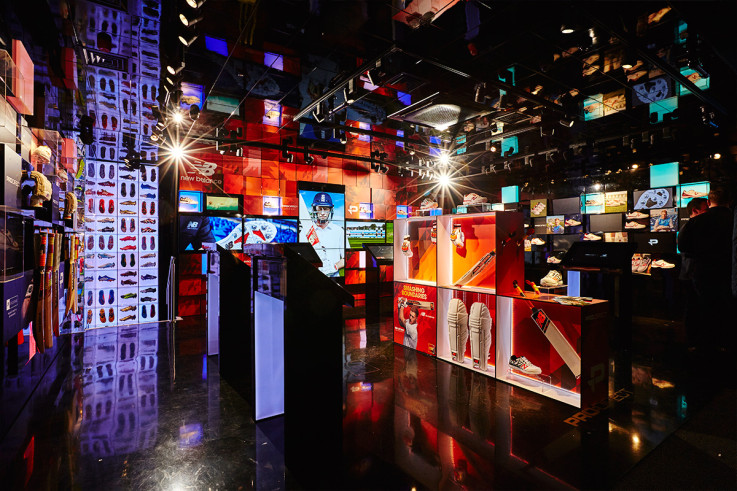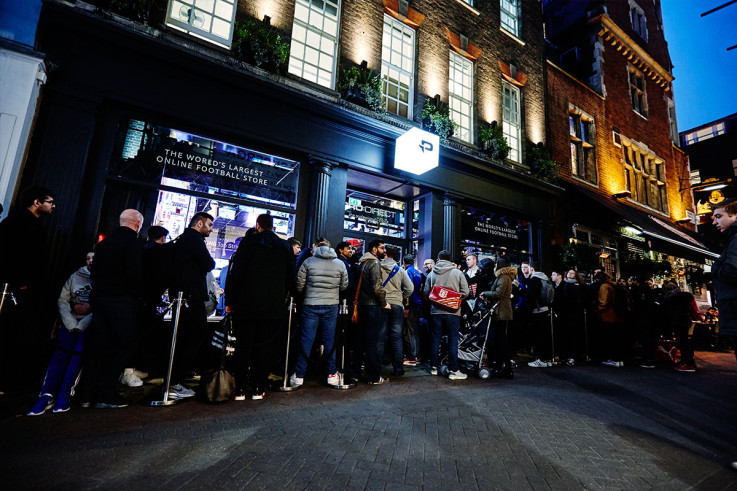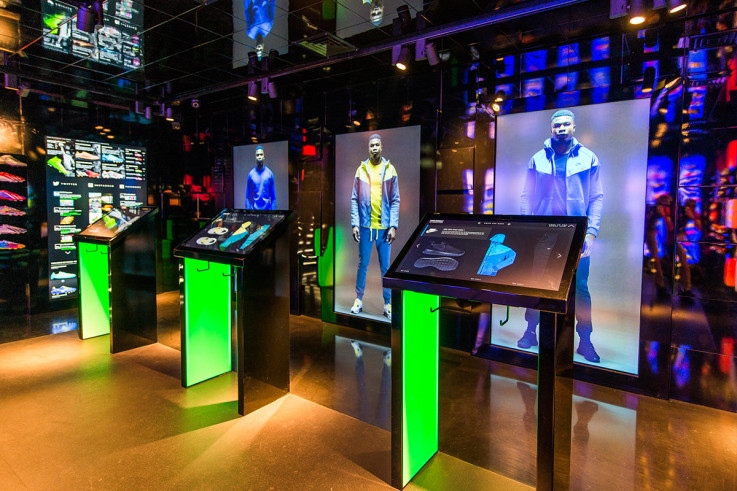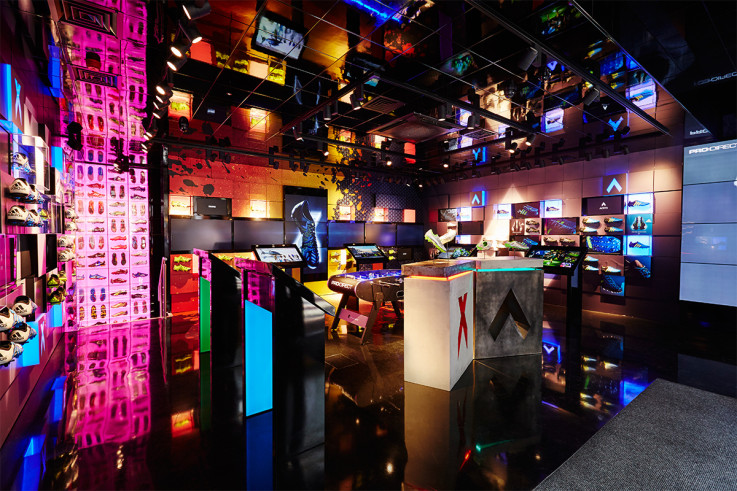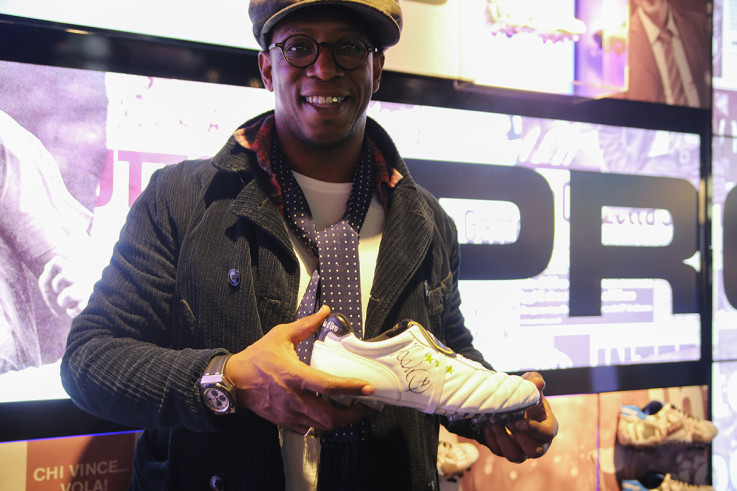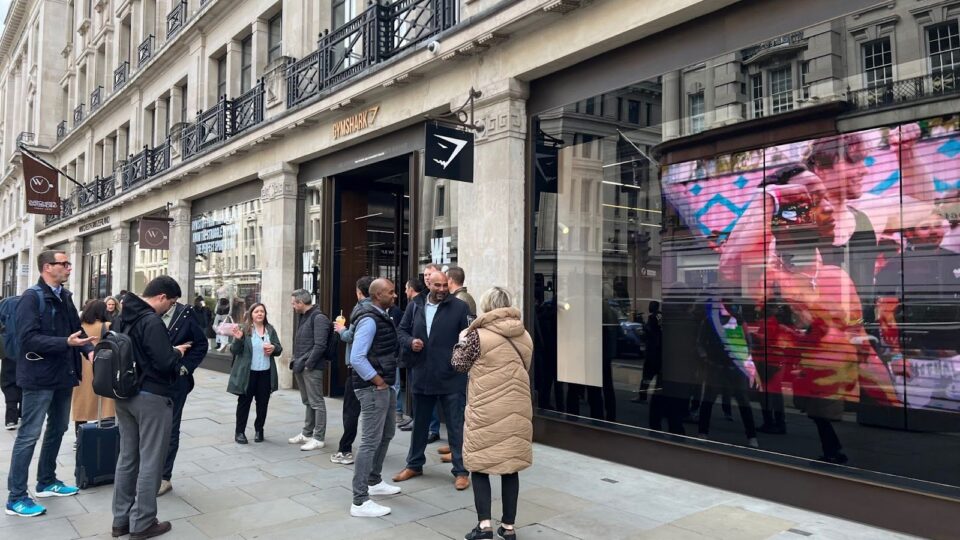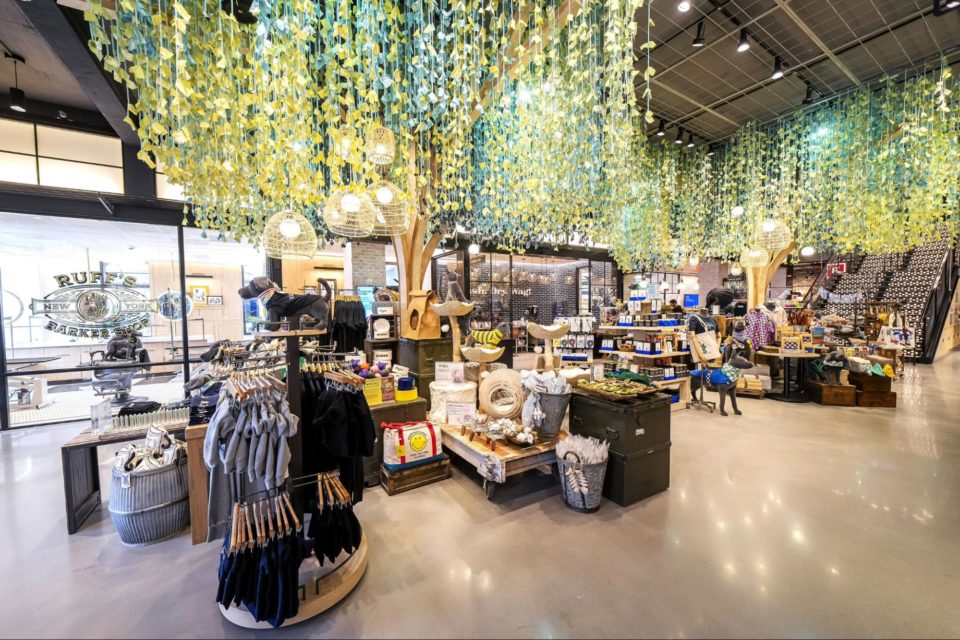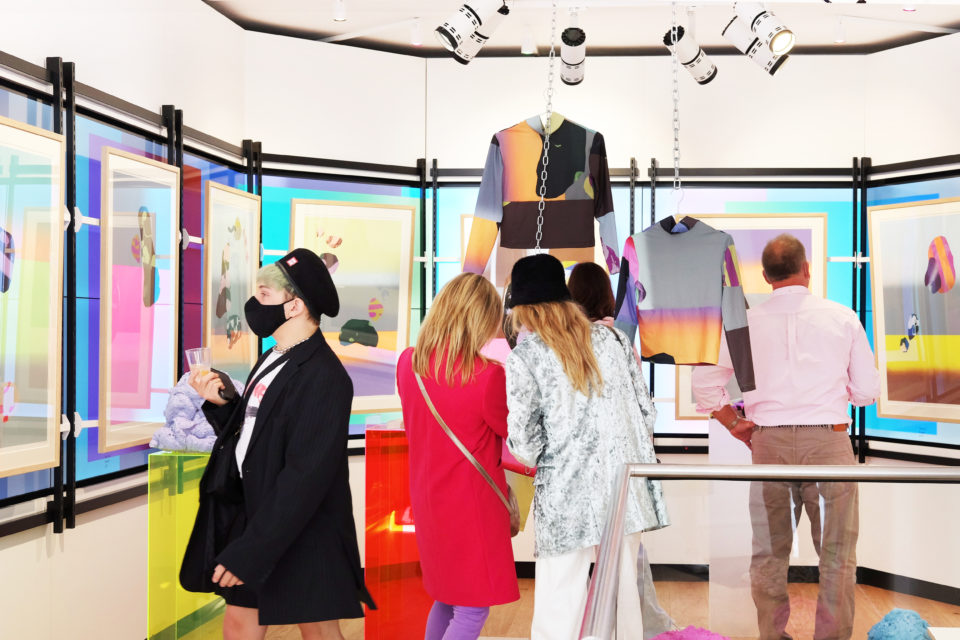Pro:Direct’s Ned Ozkasim on a different kind of retail experience
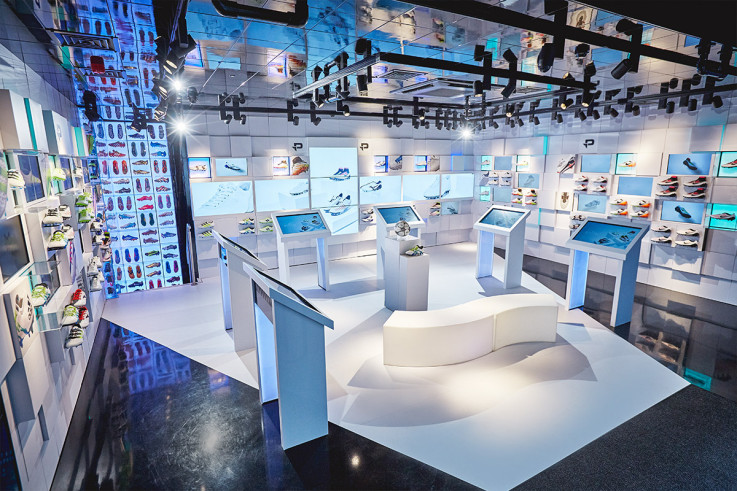
If you want to see the future of retail, take a visit to Pro:Direct’s London store. Passion and experience combine to create something that’s not just a destination, but a springboard for a deeper customer relationship. We talked to Ned Ozkasim, PR & Events Manager at Pro:Direct Sport, to get an insight into this more imaginative marrying of online and offline.
Can you describe for me in a nutshell what you do for Pro:Direct now?
I have a new role recently which is more of the PR and events side. My current role is working with prospective clients around bringing in events to our store, whether that be an athlete or an experience. One of the recent ones we had was Pantofola d’Oro, one of the Italian companies we work with, did a Made to Measure day in-store. So we were creating custom fit boots in the store. Other examples are when we work with a partner and get a player down to launch a new product. That’s primarily my focus now. But previously, I was involved in the day to day at the store in terms of how it looked, what kind of displays we put in and the customer experience aspect. It was quite nice to be in a store, because you got to see and experience a lot of what the customers were doing. I also got to meet so many people, because we had so many businesses that heard about us and wanted to come check us out. So from a networking perspective, it’s actually a really good place to be.
Can you tell me about the role of your football specialists? Do they come in and spend time on head office type of things as well?
Sometimes they would do – we like to involve them as much as possible. Part of the success of the story is the teams and how helpful they can be to our customers. We like to get them involved in as much as possible, even planning an event or giving us feedback around what sold well, so that we can buy more of the next product. Their insights are really key for us.
Do you have a team outside of the store? Or is everything run by the team at the floor?
Yes. It’s all run by myself and the team in the store. Everything is done from the store, so within that shop team. They’re also doing social media, they’re even taken photographs as well. We want to have a local identity and running it locally made it so much more natural and organic. The growth [on social media] that we had was incredible – we grew from zero to over 400,000 followers in about a year. Our global platforms are run from head office. When we put on events and stuff, the guys will also cover the global channel.
Does this cover the Pro:Direct Soccer account as well?
Instagram is our main platform. So our store Instagram platform has 425,000 now. And our store Twitter is a bit less, because it’s a bit more tricky with what we can put on there. But Instagram is all images the guys take in and around London, in the store and if we go to events, they’ll go out there as well. So everything you see on there is pretty much curated by myself and the store team. We find Instagram is a really good platform for us. If you look at Twitter’s statistics, most posts on Twitter with an image get much more interaction than just text and obviously Instagram is the best platform for image. Our global Instagram is 1.8 million I think, and then we have a global Twitter which is probably about 120,000.
Can you tell me about how the store is designed to influence or interact with the Pro:Direct website?
We are an online company. Our whole business is online and we wanted to have a presence on the high street. But we didn’t just want to be a website that had a shop. We wanted to be more involved and more connected. The brief from which we actually designed the stores was that you should feel like you’re walking into our website. It has a very similar colour scheme and the light from the digital nature of it all kind of talk that up. A lot of the content that we produce for our website, we can then repurpose and display it in the store. The content we make is actually bespoke. It’s not brand supplied images, we actually have a studio that are making all of these for us.
Our store looks very different to any other retailer that may be selling similar products. So if you went to Nike for example and saw Nike’s version of their presentation of their boots, it would be different to ours. We like to have that point of difference. The product that you see is in line with what are our lead stories on our website. They wanted that experience where if something on the website is being talked up, then it should also be talked up in the store, so you get a consistent look between the website and the shop. Whatever the top stories are for us as a brand, will be reflected across all of our channels, whether that’s social, physical store or the website.
Is it correct that some of your brands pay to have their new release featured?
It’s not really a payment to have their stuff featured and as such. We are a major partner for a lot of these brands and it’s part of our agreement together to have shop space. If they’ve got a really strong product we might say, “Oh, OK. We can put something into the store. That will help drive business.”
It’s not all about creating sales in the store. Just because we put on nice showcase in the store, it doesn’t necessarily mean you’re going to sell tens of thousands of boots in the shops. But what you do get is the influence and the rub-off across our social channels in the presentation. So it’s more of a holistic view. The activity we do in the store is to help boost our brand awareness, across all of our platforms up.
We don’t mind if people come in the store and think, “Wow this is cool,” but that they don’t necessarily buy anything on the day. Because maybe two or three weeks later when they are looking for a pair of boots or something else football related, they’ll think, “Oh, you know what? I went to Pro:Direct the other day and I really love what they do. This is the brand that gets me.” And then they’ll hopefully spend a lot in the future. Everything we do in the store isn’t necessarily geared towards selling straight away. The mechanics of a brand paying for stay isn’t quite right, it’s part of a wider partnership.
Do you have any way of measuring how many people come into store, and how the store visits influence the online sales? Or is it a more natural thing that if you engage people offline, naturally it will help the online sales?
That’s the million dollar question there. How do you track what you’ve done in-store to convey that it actually made an influence online? There’s no magic solution that we found yet, apart from maybe handing out a promo code for a discount or free delivery. You could see how many people don’t use it. Even if people come in the store and they transact on their own device, apart from maybe some IP related stuff, it’s really hard to say that it’s a good store and they bought because of what they’ve seen in the store. The way we look at it is if the company is improving day by day – which we are – then it can’t be doing any harm. The media fallout and the opportunities we’re getting – which we wouldn’t have been able to have without the store – are incredible. The events and the players we’ve had, we simply wouldn’t have been able to support that without our own store.
So there’s a whole brand benefit to having these great players in store? Is that what you’re referring to?
You are who you hang with in a way and our strapline is ‘The Professionals Choice’. We’re showing that the pros are coming to our store and interacting with the latest product, and see in Pro:Direct the place that they would come to buy their boots if they weren’t supplied by a brand. That only cements our place in the market. The store itself has become a mecca for football fans. People come to London and they tell us that it’s the first thing they wanted to do when they got to London was come check out the store. It’s like a pilgrimage almost.
How many events do you have a month at this point?
Certainly about four or five a month, at least for the moment. We’ve also started looking at special events with other categories as well. Pro:Direct is not just soccer, we have running, cricket, rugby, tennis. We’ve had events with Andy Murray. We have the All Blacks during the Rugby World Cup and had the England cricket team in lately. We don’t want to move away our football DNA during the day, but out-of-hours we’ve actually made an event space for our other categories as well.
Is it mainly players appearing? Or some of those FIFA tournaments and different things?
We like to do as many different ways as we can to interact with our consumers. Whether that’s a FIFA tournament, which isn’t a massive event but like a social activity, or player appearance, or even a boot launch. We’ve had boot launches, we’ve had freestylers. They don’t need to be a big A-list celebrity to make it a unique shopping experience. And we’re really open to trying as many different ideas as we can.
We’ve had an artist in-store painting football boots. People actually come to the store every couple of days – locals – just to see what’s going on and what the shop looks like. The shop itself changes its identity – every two or three days we’re swapping the store around, so it can look completely different if you go in on Thursday and then come in on a Friday. It’s quite a cool feature as well.
Have any of the core principles of the store or the way it functions changed since it launched in any way?
I think it’s changed in the sense that we’ve got smarter with what we do in the store and also more creative. When we first opened it was a very simple mechanic. Then we evolved into doing full wall graphics, we’ve done floor graphics, we wrap the whole of the shop. We put vinyl outside the store. We’ve even covered all the walls with grey and projected onto them. In terms of visuals, we’ve learned new techniques to maximise what we do. But the essential operation of the store is still the same.
Upstairs is for storytelling and the latest products and what’s new. And then downstairs is that kind of hang out chill out basement, where we want people to come and try the product on. We know that if somebody tries on one pair of boots, they tend to stay for about half an hour, and they’ll end up trying on three or four pairs, which is really cool. They’ll feel comfortable and they want to chat to our staff as well.
How easy is it for you to go from having an idea to seeing it live in the store?
We’re a super agile company – that’s definitely one of our strengths. We’re building things for the website, all the time, any day. For somebody to do what we do as a store without having the website is not economical. Because we’re creating content, we’re almost repurposing it and putting it in a different place. That really helps us in terms of ideas.
Again, we’re lucky that we have the resources that we do. When we built our store, the nature of it is very easy to turn things around. We can do a whole store switch around in an hour. We did that the other day where we traded as a normal shop all day until about 6pm and then we shut for an hour. Then we had the England cricket team come in and we reopened for a cricket event, with all different graphics, different centrepieces and all of the digital content changed. The digital content we actually displayed we shot that morning at Lord’s with the players.
We went out with the players in the morning, shot the content with some of our film team, edited it, and then we uploaded it in the store the same day. It allows us to be really relevant with our consumer. I think that’s where a lot of retailers are a bit behind is that you forget that – especially our target demographic which is probably 14 to 25 year olds – they’re so connected to social media. The imagery and the content that they’re seeing is up to the minute. Why should they care about what your shot looks like if the visuals that you’re showing are three to five months old, and they have been shot in a studio. They want to know what’s going on right now.
We’ve even had imagery in the store like that’s breaking news almost. In the summer of last year, if a key transfer had happened, we’d actually put the picture of the player on the wall with ‘just signs for Real Madrid’ or whatever. That’s us trying to be at the forefront of it rather than showing people what they’ve already seen. We want to show them things they haven’t seen. We’re almost curators in that sense. It gives us that massive point in difference.
Is there anything that you tried that maybe didn’t work as well as you hoped?
I don’t think there’s anything now that hasn’t worked as well as we hoped. There are things in the store that we’d like to do more with, like interactive podiums for example. We also have QR codes on the boots, so a consumer can come in and scan the boot and they get the webpage of the boot and find out more about it. A lot of our consumers they don’t even want to talk to anybody. They’re quite happy with their headphones in, on their phone, just walking around. So we try to give them their own journey. But I don’t think QR was quite the right solution for us. So we are exploring new technology like using NFC, so they could literally just touch their phone against the boot and it would give them information.
There are lots of things we know we can do better. But as a company we’re going through some digital changes and once those changes are in place, it will enable us to do even more with the store. We know there’s more in our locker, we just need to get it rolled out.
What can you tell me about what’s coming next?
We want to make the journey more personal for our consumers. We want to utilise data in a better way. Imagine if you come to the store and we know you’ve shopped with us before. You come in and it says, “Hey. We know you like Nike material. We’ve actually got a new colour waiting downstairs.” You get a notification and if you want to request your size you can hit a button, and a member of staff will know that you’re size 9 and can say “Ok we’ve got your size 9 to try on.”
It’s on our roadmap. It’s just getting the systems in place to do it. There’s a bit of a wider change throughout the company. We’re moving to a new platform, which will enable our website to be a lot more powerful and give us more tools for the store as well. It’s all about personalisation and giving a custom journey to a consumer, I think that’s our next area.
Do you know roughly when this might be live?
By the end of the year, it all depends on this big change for the whole company. We’ve grown so much in the last two years. We’ve been going through this transition for a while. We’re moving away from our legacy systems. There just wasn’t any point building code for stuff that was going to move away. Once our system rollout has changed, we can then start evolving. We’re kind of a little bit on hold at the moment. But it certainly will happen in the not too distant future.
It’s rumoured that it’s an app that you’re thinking of.
The scenario of having an app has just been floated as well, which could really beneficial to our customers. There are loads of different ways we could deploy it. I mean we’d love an app with self-service ports almost. So we can make it as seamless as possible for the consumer to access their information and get the product they need.
Do you have any other stores or are you focusing on London?
Not at the moment. London is our key demographic at the moment and key city for us. But we’re completely open to the idea of expanding, especially throughout key cities around the world. We’re not tying ourselves to the UK either. With London being a very tourist area, a lot of our consumers are telling us, “Oh we’d love one of these in Sydney, We love it in New York. We’d love it in Berlin.”
I think, when the time is right – when we first opened the store, it really was a bit of a work in process for us. We didn’t 100% know how well it would be received. Or how we would utilise it? And we ended up finding so many different use cases for it, like the events and the takeovers. It’s really become a great way for us to showcase the content that we produce, because Pro:Direct as much as we’re a retailer, we are an agency. We created all this amazing web content. The store itself has given us a great platform for it and it’s only right that we want to roll that out to other cities as well.
Can you tell me a bit more about how you recruit your staff?
When we looked for the team it was the first time we’d ever had a face for Pro:Direct. Before that essentially we were faceless – we’re a website, we have a call centre, but there was no way you could publically interact with the person of Pro:Direct. So it was super important that we got the right guys, the ones that fitted our brand image, and also going to give a great customer experience.
When we first started recruiting we used our social channels. We wanted people that were passionate about our products and passionate about football to give an authentic experience. What we found with a lot of focus groups, is that people hated going to a sports shop and being told by some spotty 16 year old kid or somebody that never kicked a football in his life what football boots they should wear. A lot of our guys have a background and they play, they’re quite a decent level, or they’re super passionate about collecting products and latest releases.
We probably had 500 applications the first time we recruited the team. We recruited ten people, so really high interest in that role. What’s really testament to it is that out of the original ten, we’ve only lost three in 19 months. For London retail to keep over 70% of your team for nearly two years is incredible. Oneof the guys that left was being relocated and he didn’t want to leave. Another guy progressed with our partners and got a job working in the industry, which is again a great success. And then one other guy just left for another job. But to keep retail employees that long I think is nearly unheard of really.
Do you think there are any other elements that make up that amazing retention rate?
I think it helps that they’ve really closely bonded as a group. They obviously had that common bond of football and passion, which brought them together. In terms of a retail role they do get some amazing experiences that you just don’t get in other roles. They get to be involved in the development of new products with brands, display testing and they get to attend all of our events with players. They get a chance sometimes to be working on the event in a lot more than a retail role. In terms of payment there’s no commission structure or anything like that. We want our guys to be open and honest and the way they do that is by being impartial.
We’re pretty much were the only place that sells the top level product of each brand side by side. Otherwise you’d have to each shop and look at their offering. So our guys can be completely objective and I think customers like the fact that if you go to Nike, they’re obviously going to tell you, that this is the best Nike product for you. Whereas what we can do, we can tell you what the best football product is for you. We can be really find out what you need. It’s quite interesting how many people come in thinking ‘this is the boot’ they want to buy, but they end up leaving with a different product, a product that’s probably more suitable for them, because they’ve learnt from our staff and the insights and the knowledge they provided them. We get the guys testing all the boots, they get access to new products. They’re always really up to date on what’s out there and what the innovations are, and what might suit a certain type of player or a certain type of foot.
Are they paid more than the average store assistant? Or is it quite similar?
It’s quite similar. Obviously what they do get is the experience side of it and they do get some product every now and then, and we like to look after them, to keep them engaged. But it’s certainly not a massive financial increase for them to be there.
Last time I was in the store I noticed that some of the guys from the shop floor were featured wearing the gear in the videos. How did that come about?
We’re obviously creating content all the time and we’ve got a lot of guys that are our target consumer. As a brand we thought it’s a nice piece of our identity that rather than hiring a faceless model or something like that, why not use some of the resources that we have in our team. It’s very cool for the guys when their mates come in, and they get treated in the same way that our pro players do. It just works. It’s a good idea I think and it gives them a sense of belonging to the company, and they feel bit special about it. It makes the content more authentic I think.
I think it’s interesting that it’s almost two years old now and it’s still one of the best experiences in the world I would say.
It’s crazy isn’t it that it’s nearly two years old and no-one has really managed to get near us in that sense. I keep an eye out on lots of things and I haven’t seen anything that’s in a very similar kind of frame to that, the nature of what we do.
We’re just really pleased with what we’ve done with the store. And if you look back at the 19 months that we’ve been open, it’s been incredible the growth that we’ve seen, and the amount of opportunities that we’re now getting. We’ve got this huge event just around the corner in June. We’re now beginning to influence, not just in football, but in other sports.
People are coming to us and saying, “Wow your store is amazing.” We have people from Chanel through Tesco to Amazon. All the big name retailers coming to our store just to see what we’ve done. I think a lot of people want to copy our model to get that omnichannel experience correct – more of an experience with retail space as opposed to just a traditional brick and mortar store. We’ve been nominated for the Retail Theatre Award from Retail Week, so hopefully we’ll win that.
We can be a bit more radical with what we do and we don’t have the traditional signage or POS. We don’t have to be regimented and a more established brand with an older clientele might have to be, because they don’t embrace change as well as the younger generation does. But I think it’s down to us as retailers to change people’s perception of how to shop. That’s one thing that we try to do apart from the rest – we would love it if people were happy to come into the store and order, but I encourage the staff all the time to find out, “do you need this pair of boots tonight?” “If you don’t need them now, let me send them to your house.”
From a store logistics perspective, it’s much easier for us to send products to your door as we have that ecosystem from our website. It is changing the mentality of a shopper – they think they want everything right now, they think they want to carry it home on the train, because it’s what they’re used to. You give somebody money, you take away a product. But what we’re trying to do is encourage them to let us fulfil this to you in the best possible way. It’s great with tourists that we can ship things. We ship to 220 countries from the store. So you could be on holiday and you’re probably not going to play football while you’re on holiday. Or you might not want to wear this particular clothing on holiday. It might be winter clothing or training. Let’s ship that back to your house for you and then you don’t have to worry about putting it on the airplane.
Even those parts of fulfilment, I don’t think other retailers have really caught on to that. Not many places that I know that you can go to and you can ship to worldwide. A lot places in the UK, but not going worldwide as well. It’s changing the consumer’s mentality on how to shop. They think they want to walk out the door with products but that’s not always the best case for them.
So you can pay for something in the store and then have it turn up at your house later on?
Absolutely. That would be my ideal way of selling everything. We had a family from Australia who came to the store. Unfortunately just before they left for their holiday they had a fire in their house and they lost a lot of their stuff. They came to the shop, a couple with three kids. One of our team sat down with them for nearly two hours and we ended up fulfilling them in three different ways. They left physically with some trainers that the kids wanted to wear Then they sent some clothes to their hotel in London, which arrived the next day. And they wanted to buy some new accessories because the guy did some coaching and we shipped them back to Australia. So in one transaction it’s been fulfilled in three different ways.
Watch this space for more interviews, retail openings and retail innovations. You can also follow us on Twitter, Facebook or check out our LinkedIn page. See you soon!

